Lookout Mountain UHF Contest, K7CVU/7, August 6, 2016
7Aug2016, 11Aug16, 1Sept16 minor
edits, Wes Hayward, w7zoi
....
One of my most most favorite activities in amateur radio is
operation combined with a hike or backpacking trip.
It's even better when the weather is near perfect and the views
are great. A great trip this summer was a trek up
Lookout Mountain, a location just 9 miles east of Oregon's Mt.
Hood. It's a relatively easy, but pleasant
hike.
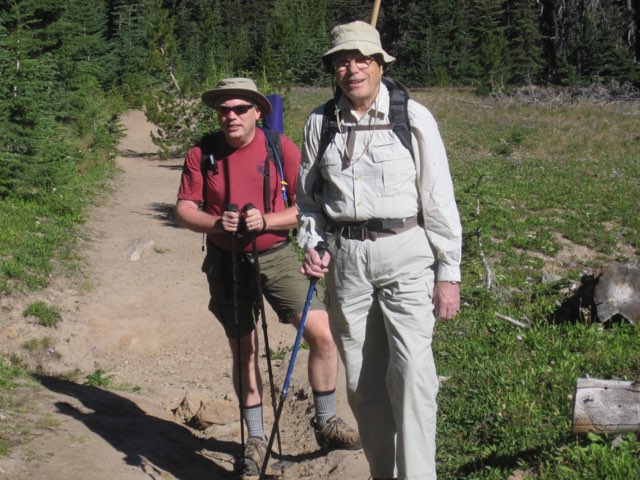 On the hike in,
KA7EXM and W7ZOI. That's the mast for our 432
MHz Yagi sticking up out of my pack. (K7CVU
photo--tnx John)
On the hike in,
KA7EXM and W7ZOI. That's the mast for our 432
MHz Yagi sticking up out of my pack. (K7CVU
photo--tnx John)
This trip was the brainchild of John, K7CVU, who has become one of
the local experimenters giving UHF a try. Roger
(KA7EXM), and I were invited to join John on this trek to a high
point that might offer some DX at frequencies above 300 MHz.
I think that John needed someone to serve as porters
to carry the batteries that would run the gear. We
have operated both Field Day and the September VHF contest from
Lookout Mtn. This was a special contest devoted
to UHF. John had recently using a
new transverter for 1296 MHz and we wanted to give it a try in the
field. The contest also included the 432 MHz band and
we thought it would be fun to give that a try
too. We used John's call for all
operation.
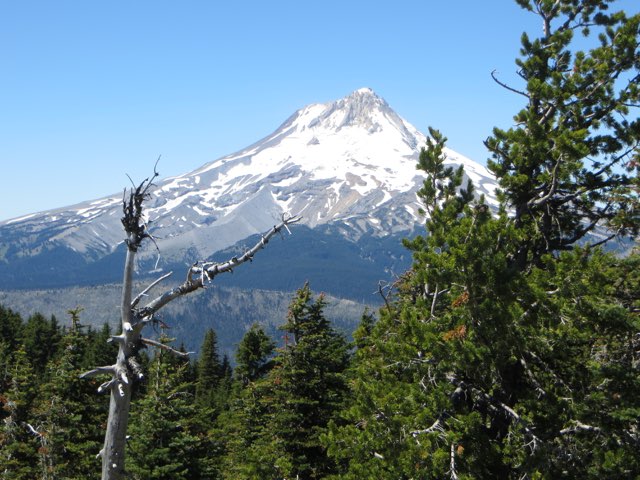 This was our view for our summit operating
position. All we had to do was to stand up from our
more relaxed operating position and this is one of the views
that we had. This is the east face of Mt.
Hood.
This was our view for our summit operating
position. All we had to do was to stand up from our
more relaxed operating position and this is one of the views
that we had. This is the east face of Mt.
Hood.
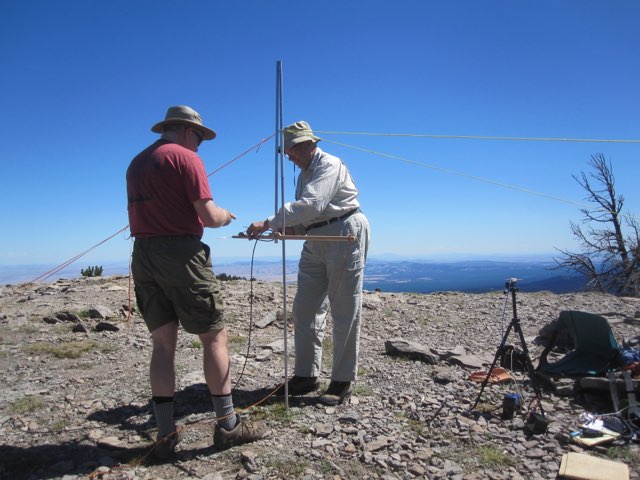 Roger and Wes assembling the
432 Yagi while John is putting the 1296 station
together. (K7CVU photo.)
Roger and Wes assembling the
432 Yagi while John is putting the 1296 station
together. (K7CVU photo.)
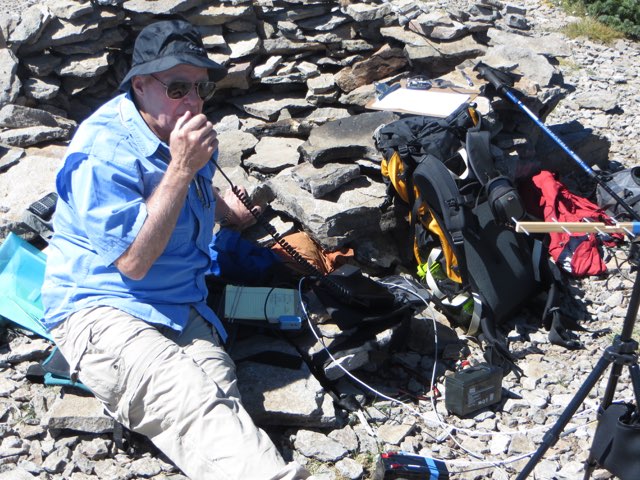 This photo shows John making
our very first contact with Mike, KB7W. This single
1296 MHz contact was enough to justify hauling all of this junk
up the hill. Mike was in Bend in grid CN93, 95
miles south of us. It was amazing just how
strong Mike's signal was. We later worked Mike
on 432 MHz.
This photo shows John making
our very first contact with Mike, KB7W. This single
1296 MHz contact was enough to justify hauling all of this junk
up the hill. Mike was in Bend in grid CN93, 95
miles south of us. It was amazing just how
strong Mike's signal was. We later worked Mike
on 432 MHz.
John's little 5 element Yagi is mounted on top of a small
tripod. The transverter resides in a black bag
that hangs on the tripod legs. We had an output of 2.5 W on
1296 and 5 W on 432. A Yaesu FT-817 was the IF for
the 1296 rig and the main rig on 432.
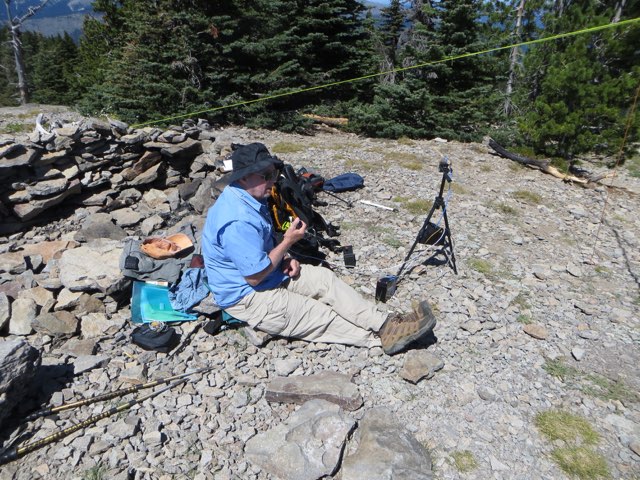 This photo shows John's
antenna pointed north toward Mt. Rainier in
Washington. This allowed us to work (via knife-edge
diffraction) Fred (WA7TZY) and Susan (WB7BST) who were in
Woodinville, CN87, north of Seattle. We
worked them on 1296 MHz CW and then SSB, but missed them on 432
MHz. Next time.
This photo shows John's
antenna pointed north toward Mt. Rainier in
Washington. This allowed us to work (via knife-edge
diffraction) Fred (WA7TZY) and Susan (WB7BST) who were in
Woodinville, CN87, north of Seattle. We
worked them on 1296 MHz CW and then SSB, but missed them on 432
MHz. Next time.
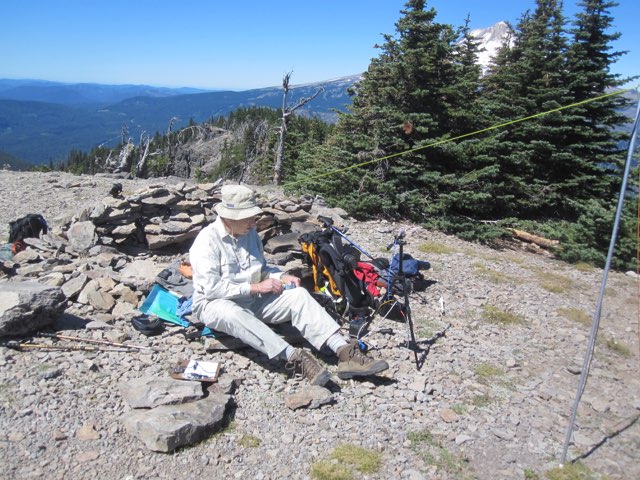 Here Wes is
working some CW on 1296. (K7CVU photo.)
Here Wes is
working some CW on 1296. (K7CVU photo.)
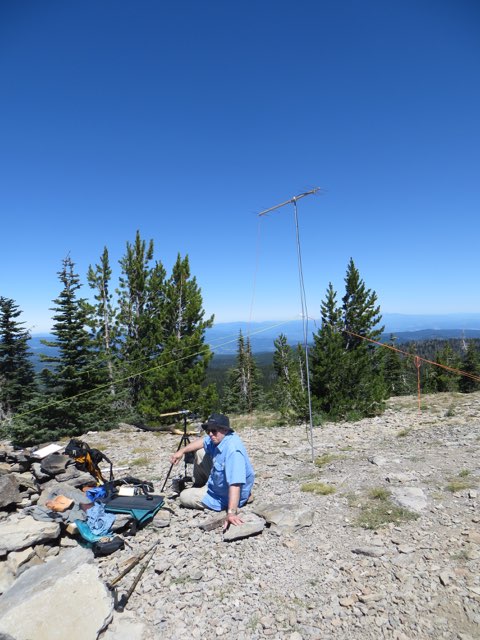 This view shows the 10 ft
pole that holds our 432 MHz Yagi. The mast
weighs just over one pound and collapses to fit in a
rucksack. The Yagi boom is about 4 ft long.
Roger and I have used this antenna set up in all seasons
for various VHF contests.
This view shows the 10 ft
pole that holds our 432 MHz Yagi. The mast
weighs just over one pound and collapses to fit in a
rucksack. The Yagi boom is about 4 ft long.
Roger and I have used this antenna set up in all seasons
for various VHF contests.
Near the end of the contest we worked Rick, KK7B, in Parkview, a
small community that was almost line of sight for us.
We worked him with ease on both 1296 and 432
MHz. Rick then returned to his house in Hood
River. Once there, it was necessary for us both to
point our antennas at Mt. Adams to be able to repeat the contacts,
now via reflection. Much weaker, but still a solid
contact. Hmm, I guess Rick must have been operating in the
"rover" category for this contest.
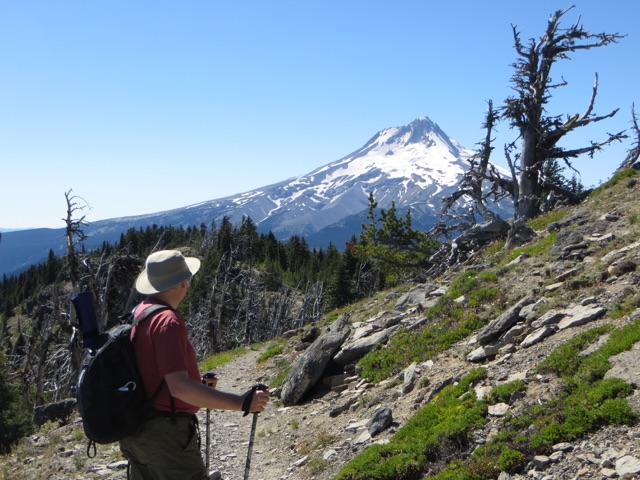 We spent about 4 hours on
top of the peak and had a ball. But alas, all
good things must end. This photo shows Roger as we
were leaving he summit.
We spent about 4 hours on
top of the peak and had a ball. But alas, all
good things must end. This photo shows Roger as we
were leaving he summit.
We hiked out through delightful meadows, drove the dusty road down
to Oregon Highway 35 and then on to Hood River where we met Rick
for Pizza and Beer. Really a great
outing. Many thanks to all the folks who
took the time to listen for us and to work us on the
air. And, many thanks to John for
inviting Roger and me to join him.
Here's an abbreviated form of our log:
1296 MHz: KB7W, W7SZ, WA7TZY, WB7BST,
KK7B. (2 CW, 3 SSB)
432 MHz: KB7W, KE7MSU, KK7B. (1
CW, 2 SSB)
I ran through some distance numbers, as did Mike,
KB7W. Mike was 95 miles south of us,
nearly line of sight. Fred and Susan, WA7TZY and
WB7BST, were 168 miles to the north of us over a path severely
dotted with mountains. Antennas for the
WA7TZY/WB7BST QSOs were pointed at Washington's Mt. Rainier.
 On the hike in,
KA7EXM and W7ZOI. That's the mast for our 432
MHz Yagi sticking up out of my pack. (K7CVU
photo--tnx John)
On the hike in,
KA7EXM and W7ZOI. That's the mast for our 432
MHz Yagi sticking up out of my pack. (K7CVU
photo--tnx John) This was our view for our summit operating
position. All we had to do was to stand up from our
more relaxed operating position and this is one of the views
that we had. This is the east face of Mt.
Hood.
This was our view for our summit operating
position. All we had to do was to stand up from our
more relaxed operating position and this is one of the views
that we had. This is the east face of Mt.
Hood. Roger and Wes assembling the
432 Yagi while John is putting the 1296 station
together. (K7CVU photo.)
Roger and Wes assembling the
432 Yagi while John is putting the 1296 station
together. (K7CVU photo.) This photo shows John making
our very first contact with Mike, KB7W. This single
1296 MHz contact was enough to justify hauling all of this junk
up the hill. Mike was in Bend in grid CN93, 95
miles south of us. It was amazing just how
strong Mike's signal was. We later worked Mike
on 432 MHz.
This photo shows John making
our very first contact with Mike, KB7W. This single
1296 MHz contact was enough to justify hauling all of this junk
up the hill. Mike was in Bend in grid CN93, 95
miles south of us. It was amazing just how
strong Mike's signal was. We later worked Mike
on 432 MHz.  This photo shows John's
antenna pointed north toward Mt. Rainier in
Washington. This allowed us to work (via knife-edge
diffraction) Fred (WA7TZY) and Susan (WB7BST) who were in
Woodinville, CN87, north of Seattle. We
worked them on 1296 MHz CW and then SSB, but missed them on 432
MHz. Next time.
This photo shows John's
antenna pointed north toward Mt. Rainier in
Washington. This allowed us to work (via knife-edge
diffraction) Fred (WA7TZY) and Susan (WB7BST) who were in
Woodinville, CN87, north of Seattle. We
worked them on 1296 MHz CW and then SSB, but missed them on 432
MHz. Next time. Here Wes is
working some CW on 1296. (K7CVU photo.)
Here Wes is
working some CW on 1296. (K7CVU photo.) This view shows the 10 ft
pole that holds our 432 MHz Yagi. The mast
weighs just over one pound and collapses to fit in a
rucksack. The Yagi boom is about 4 ft long.
Roger and I have used this antenna set up in all seasons
for various VHF contests.
This view shows the 10 ft
pole that holds our 432 MHz Yagi. The mast
weighs just over one pound and collapses to fit in a
rucksack. The Yagi boom is about 4 ft long.
Roger and I have used this antenna set up in all seasons
for various VHF contests. We spent about 4 hours on
top of the peak and had a ball. But alas, all
good things must end. This photo shows Roger as we
were leaving he summit.
We spent about 4 hours on
top of the peak and had a ball. But alas, all
good things must end. This photo shows Roger as we
were leaving he summit.